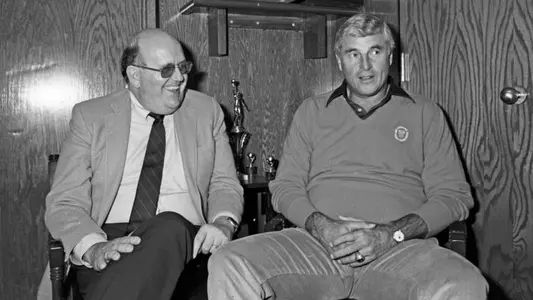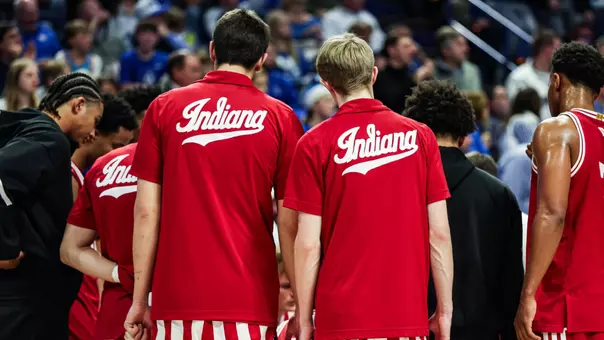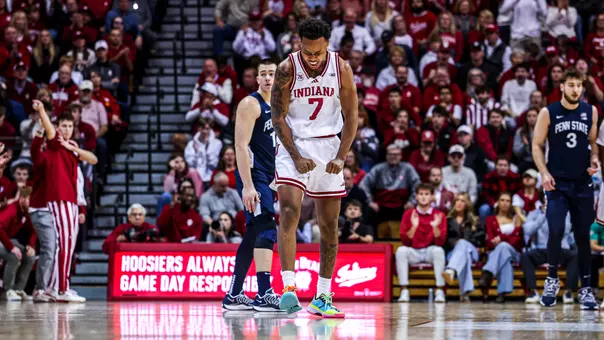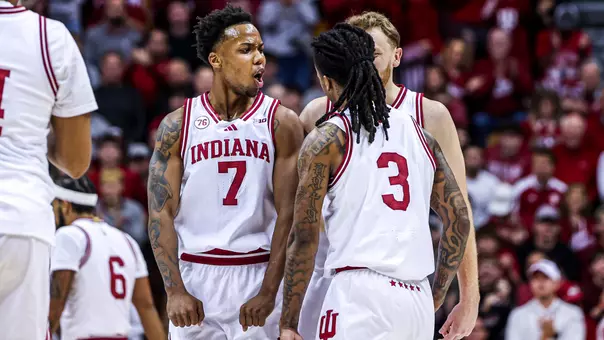Indiana University Athletics

IU Family Mourns the Loss of Bob Knight
11/2/2023 12:00:00 PM | Men's Basketball
Bob Knight's national celebrity linked him with his Indiana years (1971-2000), a 29-year stretch in which he won an unmatched eight outright Big Ten championships. He did that while changing both Indiana's and the league's reputation for physical, high-speed fast-break play to just-as-physical but more defense-oriented play focused on getting high-percentage shots every possession on offense and denying the same each trip on defense.
He grew up in football country: Ohio, his hometown little Orrville, his birth in neighboring Massillon Hospital, a town legendary for its high school football. He played high school football as an end but his game was basketball, his ticket to college education at Ohio State. There he was part of the greatest basketball run in school history: its only NCAA championship in his sophomore year (1960), outright Big Ten championships in all three of his varsity seasons as sixth man on Fred Taylor-coached teams that included Knight classmates John Havlicek, Jerry Lucas, Mel Nowell and Gary Gearhart. Taylor, Knight, Havlicek and Lucas all are in the Naismith International Basketball Hall of Fame.
After one year as an assistant basketball coach under Harold Andreas at Cuyahoga Falls High School, Knight joined the Army – its recruiting pitch at the time: "Be all that you can be." He became one of the motto's best illustrations, though a different kind of uniform was involved.
His two-year Army hitch after boot camp sent him to West Point as an assistant coach under almost-as-young head coach Tates Locke. After two years, when Locke left Army to go to Miami (Ohio), Knight at 24 became the youngest head coach in major college basketball. In the next six years, the Cadets went 102-50, by far the most successful basketball stretch in Academy history. His teams went 6-0 against archrival Navy, an anomale in a series dominated by Navy. His scrappy, undersized, intelligent teams became a Madison Square Garden darling, booked for regular-season games almost every year and a regular in the National Invitation Tournament. In that period, Knight so loved the NIT that he was the last coach to reject an NCAA tournament berth to play in the NIT. At career's end, no achievement – including three NCAA championships – brought such a gleeful display of celebration from him as when his 1979 Hoosiers won the NIT.
By then, he and IU were titans of the college game.
He accepted the Indiana job while still 30 in March 1971. His first game, an 84-77 win over Ball State, was the first at spanking-new Simon Skjodt Assembly Hall. His first Indiana team sold his aggressive but more offensively patient game to "Hurryin' Hoosier" fans by beating Kentucky and Adolph Rupp 90-89 in double overtime in his fourth IU game. Center Steve Downing, who became a lifetime friend, scored 47 points and had 25 rebounds in playing all 50 minutes of that epochal game at Louisville's Freedom Hall. That team lost its first four Big Ten games, then finished 9-5 (18-7 overall) and was IU's first to play in the NIT.
The next year, the first in which the NCAA dropped its rule banning freshmen from football and basketball, the Hoosiers went 22-6, won the Big Ten and advanced to Knight's first Final Four, losing there to champion UCLA despite a furious comeback that fell short when Downing, after outscoring three-time Player of the Year Bill Walton 26-14, fouled out.
IU had made that tournament run with freshman guards Quinn Buckner and Jim Crews. The next year, three others brought in with them in that first year of freshman eligibility – Scott May, Bobby Wilkerson and Tom Abernethy – melded in with Knight's first-year recruits, Steve Green and John Laskowski, and freshman Kent Benson took Downing's spot. As good as that three-year run he was in on at Ohio State was, he was about to coach the only team that topped it. The 1973-74 Hoosiers were Big Ten co-champions with Michigan, won the post-season Conference Commissioners Association tournament, finished 23-5, and then made history.
In 1974-75, the Hoosiers went through their schedule unbeaten, ranked No. 1 in the country the season's last two months, but lost first-team All-American May to a broken arm in late February and lost in the NCAA Mideast Regional finals to Kentucky, 92-90 – a rival the Hoosiers with a healthy May had led 88-54 before emptying the bench in a 98-74 regular-season game.
Green and Laskowski were graduation losses from that 31-1 team, but all else were back and dedicated. They repeated the 18-0 Big Ten run, went 27-0 while No. 1 through the full schedule, then one-by-one turned back challengers that included No. 2-ranked, once-beaten Marquette in the regional finals and reigning champion UCLA in the semifinals. Early in the championship game against Michigan, the Big Ten runnerup that had come closest to upending the Hoosiers before losing in overtime at Simon Skjodt Assembly Hall in February, IU lost first-round NBA draft pick Wilkerson to a concussion. Michigan led 35-29 at halftime. IU won 86-68, the now-or-never 57-point second half still the most points ever scored in a half of a national championship game.
Also still unmatched is the 37-game Big Ten winning streak during that two-year period – the next-longest - 27 by Knight's Ohio State teams. He's the only Big Ten-based coach of a gold-medal U.S. Olympic basketball team (1984), and a gold-medal U.S. Pan-American Games team (1979).
Approaching half-a-century later, no team has ever supplanted Indiana 1976 as the last perfect-record NCAA men's major-college champion. In fact, every champion since has lost at least twice. At the 75th NCAA championship in 2013, that 1976 IU team was picked in a national fans' vote as the All-Time Final Four champion and brought with Knight to Atlanta to be recognized. A sign at the south end of Simon Skjodt Assembly Hall recognizes that vote.
The NIT title came in 1979, after a closing rush and tournament run led by the present IU coach, Mike Woodson. Other NCAA championships came in 1981 (sophomore Isiah Thomas the All-American leader) and 1987 (Steve Alford the All-American, Keith Smart the game-winning shotmaker). Further Big Ten titles became common: outright in 1980, '81, '83, '89 and '93, co-championships in '87 and '92 – 11 titles in all in Knight's 29 seasons. His 1990s teams added no national titles but won a Simon Skjodt Assembly Hall-record 50 straight home games. The 1992 Hoosiers reached the Final Four. The 1993 team was ranked No. 1 in the country five weeks and had the college Player of the Year in Calbert Cheaney, still the career scoring recordholder for both IU and the Big Ten.
Knight coached with an intensity that included a quick-triggered temper, his New York press nickname in his West Point days "Bobby T," for his technical fouls. An essential charge of insubordination brought his firing by IU President Myles Brand in September while Knight was preparing a young team for the start of the 2000-01 season, which would have been his 30th at Indiana. He went on to coach seven years at Texas Tech, along the way passing a rival and friend, North Carolina's Dean Smith, as the winningest major college coach in men's history, then becoming the first to win 900 games. Since then, a captain on his Army teams and a graduate assistant coach at IU during the 1974-75 season, Mike Krzyzewski, succeeded him as the recordholder in career wins. At IU, Knight was 662-239, batting a record .700 in Big Ten play at 353-151.
In 2000, he was named the Big Ten's basketball Coach of the Century. The league that he had restyled with his basketball teachings produced the champions of four of the first 32 NCAA tournaments, six in the 29 Knight-at-Indiana years, and none in the 23 since. He and a Hall of Fame IU predecessor, Branch McCracken (1940 and 1953), are the only Big Ten coaches to win more than one NCAA title.
**Contributed by Bob Hammel
He grew up in football country: Ohio, his hometown little Orrville, his birth in neighboring Massillon Hospital, a town legendary for its high school football. He played high school football as an end but his game was basketball, his ticket to college education at Ohio State. There he was part of the greatest basketball run in school history: its only NCAA championship in his sophomore year (1960), outright Big Ten championships in all three of his varsity seasons as sixth man on Fred Taylor-coached teams that included Knight classmates John Havlicek, Jerry Lucas, Mel Nowell and Gary Gearhart. Taylor, Knight, Havlicek and Lucas all are in the Naismith International Basketball Hall of Fame.
After one year as an assistant basketball coach under Harold Andreas at Cuyahoga Falls High School, Knight joined the Army – its recruiting pitch at the time: "Be all that you can be." He became one of the motto's best illustrations, though a different kind of uniform was involved.
His two-year Army hitch after boot camp sent him to West Point as an assistant coach under almost-as-young head coach Tates Locke. After two years, when Locke left Army to go to Miami (Ohio), Knight at 24 became the youngest head coach in major college basketball. In the next six years, the Cadets went 102-50, by far the most successful basketball stretch in Academy history. His teams went 6-0 against archrival Navy, an anomale in a series dominated by Navy. His scrappy, undersized, intelligent teams became a Madison Square Garden darling, booked for regular-season games almost every year and a regular in the National Invitation Tournament. In that period, Knight so loved the NIT that he was the last coach to reject an NCAA tournament berth to play in the NIT. At career's end, no achievement – including three NCAA championships – brought such a gleeful display of celebration from him as when his 1979 Hoosiers won the NIT.
By then, he and IU were titans of the college game.
He accepted the Indiana job while still 30 in March 1971. His first game, an 84-77 win over Ball State, was the first at spanking-new Simon Skjodt Assembly Hall. His first Indiana team sold his aggressive but more offensively patient game to "Hurryin' Hoosier" fans by beating Kentucky and Adolph Rupp 90-89 in double overtime in his fourth IU game. Center Steve Downing, who became a lifetime friend, scored 47 points and had 25 rebounds in playing all 50 minutes of that epochal game at Louisville's Freedom Hall. That team lost its first four Big Ten games, then finished 9-5 (18-7 overall) and was IU's first to play in the NIT.
The next year, the first in which the NCAA dropped its rule banning freshmen from football and basketball, the Hoosiers went 22-6, won the Big Ten and advanced to Knight's first Final Four, losing there to champion UCLA despite a furious comeback that fell short when Downing, after outscoring three-time Player of the Year Bill Walton 26-14, fouled out.
IU had made that tournament run with freshman guards Quinn Buckner and Jim Crews. The next year, three others brought in with them in that first year of freshman eligibility – Scott May, Bobby Wilkerson and Tom Abernethy – melded in with Knight's first-year recruits, Steve Green and John Laskowski, and freshman Kent Benson took Downing's spot. As good as that three-year run he was in on at Ohio State was, he was about to coach the only team that topped it. The 1973-74 Hoosiers were Big Ten co-champions with Michigan, won the post-season Conference Commissioners Association tournament, finished 23-5, and then made history.
In 1974-75, the Hoosiers went through their schedule unbeaten, ranked No. 1 in the country the season's last two months, but lost first-team All-American May to a broken arm in late February and lost in the NCAA Mideast Regional finals to Kentucky, 92-90 – a rival the Hoosiers with a healthy May had led 88-54 before emptying the bench in a 98-74 regular-season game.
Green and Laskowski were graduation losses from that 31-1 team, but all else were back and dedicated. They repeated the 18-0 Big Ten run, went 27-0 while No. 1 through the full schedule, then one-by-one turned back challengers that included No. 2-ranked, once-beaten Marquette in the regional finals and reigning champion UCLA in the semifinals. Early in the championship game against Michigan, the Big Ten runnerup that had come closest to upending the Hoosiers before losing in overtime at Simon Skjodt Assembly Hall in February, IU lost first-round NBA draft pick Wilkerson to a concussion. Michigan led 35-29 at halftime. IU won 86-68, the now-or-never 57-point second half still the most points ever scored in a half of a national championship game.
Also still unmatched is the 37-game Big Ten winning streak during that two-year period – the next-longest - 27 by Knight's Ohio State teams. He's the only Big Ten-based coach of a gold-medal U.S. Olympic basketball team (1984), and a gold-medal U.S. Pan-American Games team (1979).
Approaching half-a-century later, no team has ever supplanted Indiana 1976 as the last perfect-record NCAA men's major-college champion. In fact, every champion since has lost at least twice. At the 75th NCAA championship in 2013, that 1976 IU team was picked in a national fans' vote as the All-Time Final Four champion and brought with Knight to Atlanta to be recognized. A sign at the south end of Simon Skjodt Assembly Hall recognizes that vote.
The NIT title came in 1979, after a closing rush and tournament run led by the present IU coach, Mike Woodson. Other NCAA championships came in 1981 (sophomore Isiah Thomas the All-American leader) and 1987 (Steve Alford the All-American, Keith Smart the game-winning shotmaker). Further Big Ten titles became common: outright in 1980, '81, '83, '89 and '93, co-championships in '87 and '92 – 11 titles in all in Knight's 29 seasons. His 1990s teams added no national titles but won a Simon Skjodt Assembly Hall-record 50 straight home games. The 1992 Hoosiers reached the Final Four. The 1993 team was ranked No. 1 in the country five weeks and had the college Player of the Year in Calbert Cheaney, still the career scoring recordholder for both IU and the Big Ten.
Knight coached with an intensity that included a quick-triggered temper, his New York press nickname in his West Point days "Bobby T," for his technical fouls. An essential charge of insubordination brought his firing by IU President Myles Brand in September while Knight was preparing a young team for the start of the 2000-01 season, which would have been his 30th at Indiana. He went on to coach seven years at Texas Tech, along the way passing a rival and friend, North Carolina's Dean Smith, as the winningest major college coach in men's history, then becoming the first to win 900 games. Since then, a captain on his Army teams and a graduate assistant coach at IU during the 1974-75 season, Mike Krzyzewski, succeeded him as the recordholder in career wins. At IU, Knight was 662-239, batting a record .700 in Big Ten play at 353-151.
In 2000, he was named the Big Ten's basketball Coach of the Century. The league that he had restyled with his basketball teachings produced the champions of four of the first 32 NCAA tournaments, six in the 29 Knight-at-Indiana years, and none in the 23 since. He and a Hall of Fame IU predecessor, Branch McCracken (1940 and 1953), are the only Big Ten coaches to win more than one NCAA title.
**Contributed by Bob Hammel
IUWBB Highlights vs. ULM
Friday, December 12
Darian DeVries Pregame Press Conference
Thursday, December 11
FB: Curt Cignetti - Pre-Heisman Press Conference
Thursday, December 11
FB: Fernando Mendoza - Pre-Heisman Press Conference
Wednesday, December 10




